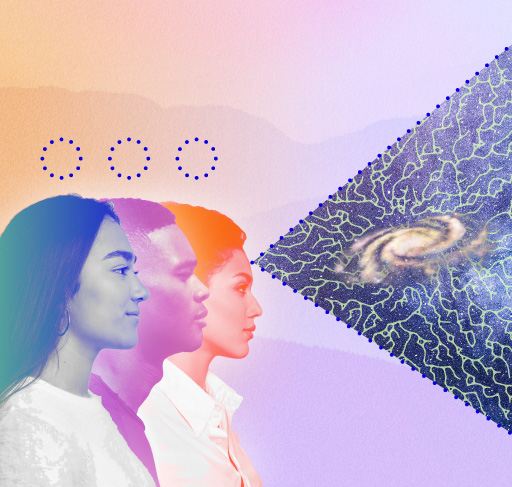Over the last few decades, there has been a groundswell of social change initiatives that have emerged whose primary purpose is to solve intractable problems, some more successful than others. What has become evident to many change leaders is that linear thinking and top-down approaches cannot solve interconnected and widespread problems.
More recently, there has been a push to embrace community-led change and design approaches that honor and address the complexity of individuals and systems. Multi-Dimensional Design (MDD) is one such approach that seeks to develop sustainable, holistic, and integrated design solutions for social impact that break problematic norms and disrupt existing power dynamics.

August 3, 2019: Photo of Tomas, Preeta and Lexx in New Jesery following a dinner where they created MDD.
Developed by Idea2Form (I2F), a BIPOC-led design studio and strategy consultancy specializing in social impact, Multi-Dimensional Design was designed in 2018 by collaborators Tomas Alvarez III, Lexx Valdez, and Dr. Preeta M. Banerjee. Multi-Dimensional Design represents a set of mindsets, processes, and practices that inform how changemakers approach design challenges and generate solutions.
Mindsets
Systems thinking contends that inequality is the result of systems or underlying structures that stem from problematic mindsets and beliefs (e.g., white supremacy, colonialism, patriarchy, etc.). At Idea2Form, we believe that by shifting mindsets, we can co-create more equitable systems with our clients that yield better outcomes for all. This work requires critical examination of oppressive systems alongside individual and collective healing. Several models illustrate this type of mindset shift, which is also referred to as paradigm shift. Idea2Form utilizes a model conceptualized by our close collaborator and partner Edgar Villanueva for his groundbreaking book Decolonizing Wealth: Indigenous Wisdom to Heal Divides and Restore Balance. Villanueva argues that to solve inequality, we must shift from a colonized mindset (divide, conquer, exploit) to a decolonized mindset (connect, relate, belong).
Multi-Dimensional Design attempts to decolonize design. It is an emergent design philosophy rooted in Indigenous knowledge and an Indigenous worldview that honors the connection between individuals and systems (natural and constructed). MDD embraces multiple intelligences that defy convention and centers on five core values: agency, deep-listening, intuition, divergent thinking, and mutuality.
Multi-Dimensional Design also requires five distinct mindsets:
- Rooted / Mindful — When approaching a design project, we must stay rooted in the five core values of MDD and remain mindful of our biases and blind spots.
- Multifaceted / Holistic — To be an impactful designer, we must see humans as multidimensional beings. We must also understand the interconnectedness of the parts and the whole if we are going to design holistically.
- Sustainable / Futuristic — We draw from the past and use the present to design for the future in a resourceful and sustainable way.
- Integrated / Collaborative — We generate transformative solutions and integrate key components through meaningful collaboration.
- Agile / Authentic — MDD requires being flexible and responsive while remaining true to one’s values and boundaries. MDD is perceptive, intuitive, and iterative.

Illustration of the phases of Idea2Form’s Design Process
Processes
Multi-Dimensional Design features a four-phase design process. Below is a breakdown of each phase and its objective:
- Discovery — Through research, the design team gathers key inputs and insights to form a deeper understanding of the design challenge and objectives.
- Design — In this phase, the design team uses information gathered from the discovery phase to unearth, test, and iterate design solutions that are integrated, holistic, and sustainable.
- Transformation — In this phase, the design team makes solutions come to life by leveraging the talent of our multidisciplinary team and creative networks.
- Transition — A transition plan is imperative to release a design into the world. In this phase, the design team transfers all project knowledge and assets to ensure a lasting impact.
Although each phase builds on previous steps, they are not linear in some cases.
Practices
There are several practices that Multi-Dimensional Design draws upon. Below are some of the frameworks that inform MDD:
- Social entrepreneurship is the practice of developing innovative solutions and mobilizing available resources to impact widespread change. According to Ashoka, an early pioneer and leader in the field, social entrepreneurs possess four unique characteristics: creativity, entrepreneurial quality, social impact of the idea, and ethical fiber.
- Network leadership is a growing body of work that looks at how some social entrepreneurs are transcending the limitations of their organizations (i.e., lack of resources and other constraints) to have a more significant impact through the strategic use of smart networks. Network Leadership shifts the focus from organizational outputs to network-level impacts. Jane Wei-Skillern, a leading researcher in the field, developed the principles of network leadership; (1) focus on mission before organization, (2) manage through trust, not control, (3) promote others, not yourself, and (4) build constellations, not stars.
- Emergent strategy is the process for creating change that is open, agile, and inspired by the patterns and processes found in nature to achieve equilibrium. adrienne maree brown, author of Emergent Strategy: Shaping Change, Changing Worlds, defines this practice as “how we intentionally change in ways that grow our capacity to embody the just and liberated worlds we long for.”
- Participatory design (originally co-operative design & now often co-design) is an approach to design attempting to actively and meaningfully involve all stakeholders (e.g., youth, partners, citizens, end-users) in the design process to help ensure the result meets their needs, is usable, and is culturally congruent.
Multi-Dimensional Design is an ever-evolving philosophy. It can help changemakers design solutions that respect the dignity of communities and embrace the complexity of individuals and systems to achieve more impact.






